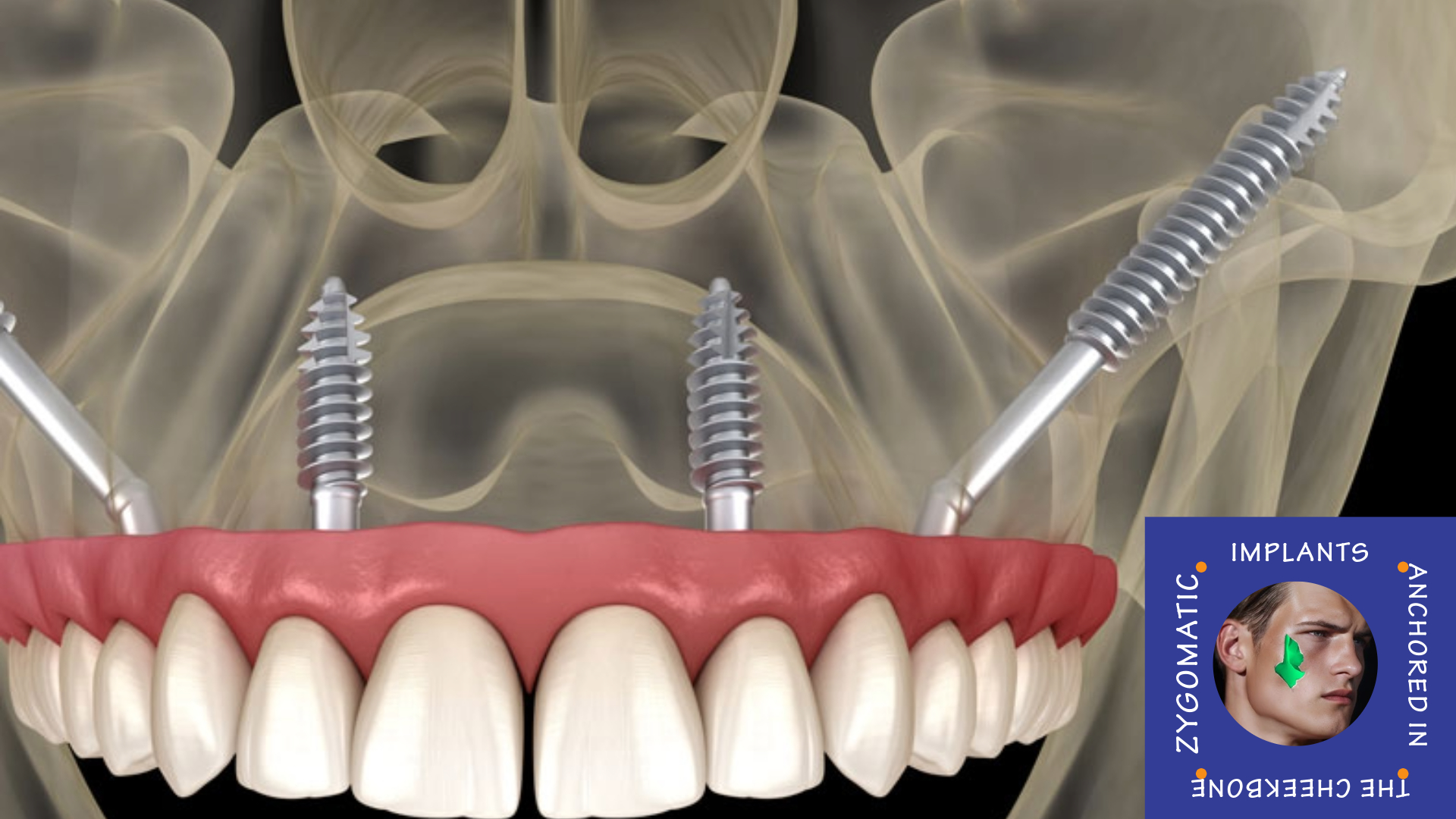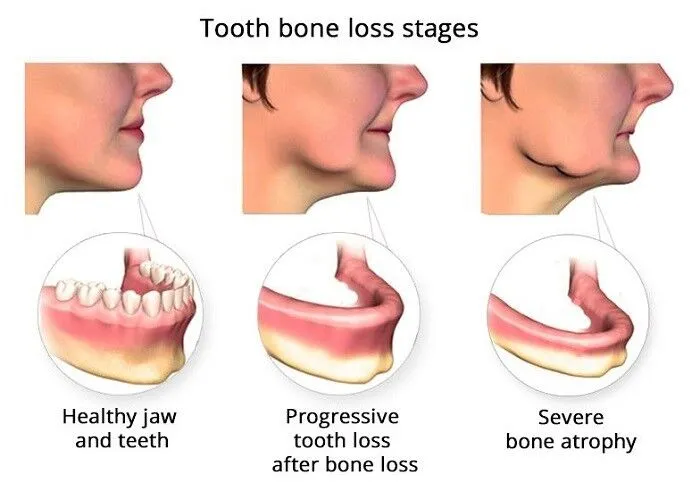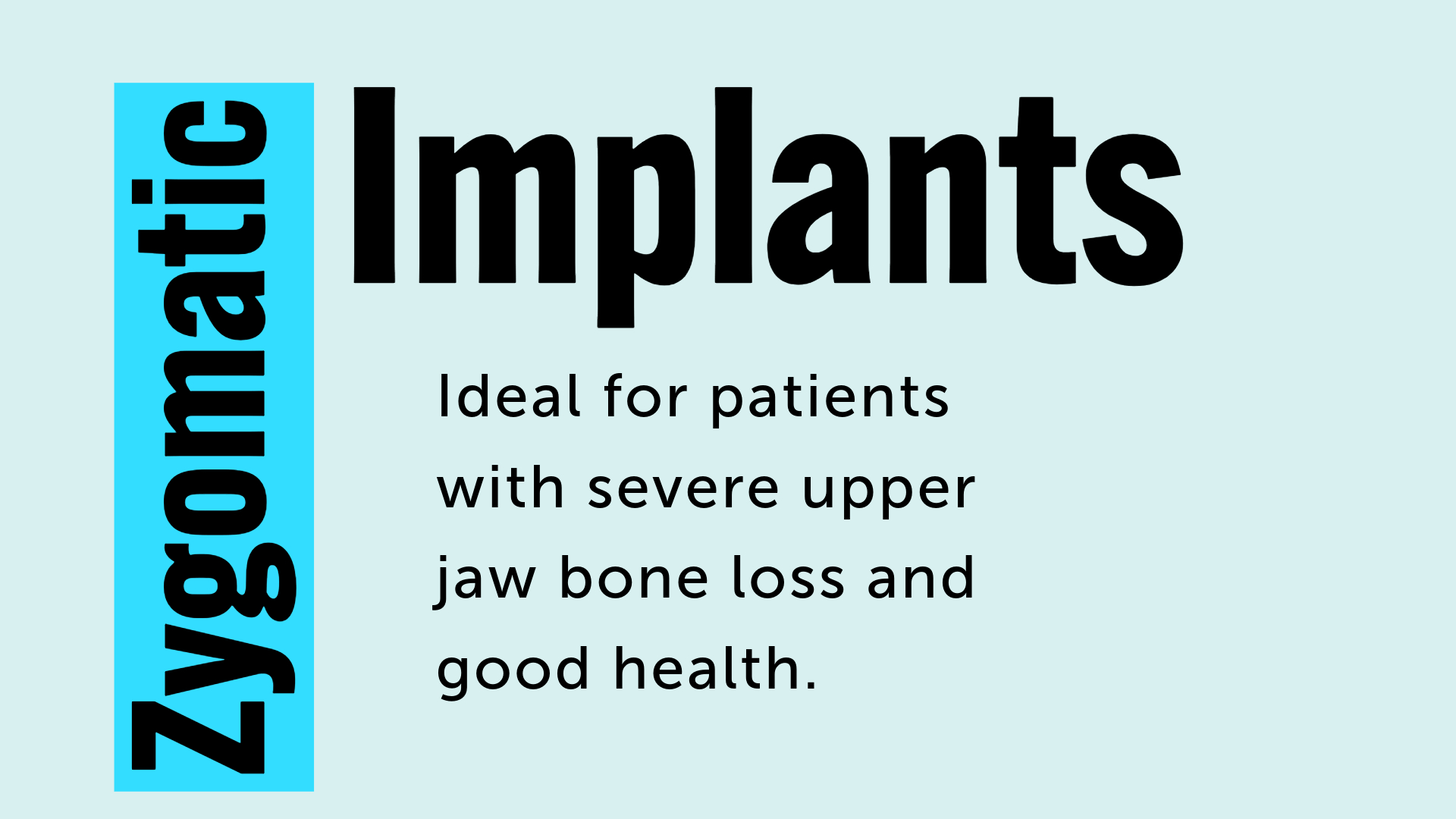
A zygomatic implant, a specialized dental implant, is positioned in the zygoma bone found within the cheekbone. It is much longer than conventional dental implants and has been developed to provide a solution for bone insufficiency in the upper jaw. While standard implants are usually 8-15 mm long, zygomatic implants can reach a length of approximately 30-50 mm. These implants support fixed dental prostheses by attaching to the cheekbone instead of the jaw when there is not enough bone in the upper jawbone. Even patients with severe bone loss can get the chance to have permanent teeth thanks to zygomatic implants.
Why and in which cases are zygomatic implants preferred?

Zygomatic implants are preferred in cases of severe bone resorption or bone deficiency in the upper jaw. It may be difficult to place a classical implant in patients who have used dentures for many years or in patients who have lost bone support due to advanced periodontitis (gum disease). In such cases, the zygomatic implant provides the opportunity to perform implant treatment without the need for additional surgical procedures such as bone grafting (adding bone powder) or sinus lifting.
In addition, zygomatic implants offer an alternative solution for patients who have lost part of their upper jaw as a result of trauma or tumour surgery, those with congenital problems such as cleft lip and palate, or those whose previous implant attempts have failed. In short, zygomatic implants are preferred in cases where normal implants cannot be made or long and laborious bone augmentation procedures are not desired.
Comparison of Zygmatic Implant and Normal Implant
Although there are dozens of implant types in the normal implant category, zygmantic implants are completely different from these implants. The main differences are as follows.
Difference in location and size:
While normal dental implants are placed in the jawbone, zygomatic implants are placed in the cheekbone. In this way, implants can be placed even if there is no bone in the upper jaw. Zygomatic implants are longer than standard implants and pass through the jaw and are fixed to the cheekbone felt in the cheek.
Treatment procedure and area of use:
Classical implants can be used in many cases ranging from a single missing tooth to complete edentulism and are usually placed under local anaesthesia in a smaller operation. Zygomatic implants are mostly used in cases of complete edentulism or when a full bridge is required, especially when there is no bone in the posterior regions of the upper jaw. These procedures are usually performed under general anaesthesia or deep sedation by experienced surgeons. A zygomatic implant is capable of supporting more than one tooth, whereas a normal implant is usually used to support one or two teeth.
As a result, the zygomatic implant has a more specialised indication compared to conventional implants; it is not designed for every patient, but only for situations where it is needed. Both are made of titanium and are fixed by integration with living bone (osseointegration), so both have a high success rate when applied correctly.
Advantages

The main advantages of zygomatic implants are as follows:
- No need for bone graft: The biggest advantage is that even if there is bone deficiency in the upper jaw, there is no need for additional bone surgery. The implant can be placed directly into the cheekbone without bone grafting or sinus lifting. This shortens the treatment time and eliminates the extra surgical burden for the patient.
- Fast tooth regain: Patients with zygomatic implants can usually get their teeth on the same day. A temporary fixed prosthesis can be inserted immediately after the implants are placed, so that the patient is not toothless after the operation and does not have to use removable prostheses. The time from the beginning to the end of the treatment is shorter than with conventional methods with bone graft.
- High stability and multiple tooth support: The zygomatic bone is a very hard and dense bone, which allows the implant to achieve a firm hold. One zygomatic implant can support several teeth; for example, a single zygomatic implant can support a bridge of 3-4 teeth. Fixed prosthesis can be made for all upper jaw teeth of a patient using four zygomatic implants. In this way, more tooth support can be provided with fewer implants.
- High success rate: Studies show that the success rate of zygomatic implants reaches 95-97%, which is close to traditional implants. Zygomatic implants are extremely successful in the long term when applied by appropriate case selection and experienced surgeons. This allows patients to prefer this treatment with confidence.
- Solution in special cases: Zygomatic implants offer an option in cases that are difficult to treat with other methods. For example, in patients with congenital cleft lip or palate, it can support prostheses in upper jaw bone deficiencies. It also provides a quick alternative for patients who have previously been unable to have implants due to bone insufficiency or who do not favour long treatments with bone grafts. It can also be used to "rescue" previously unsuccessful implant treatments; in other words, a patient with bone that normal implants cannot hold on to can be given another chance with a zygomatic implant.
Disadvantages

As with any treatment method, zygomatic implant application has some disadvantages and difficulties:
- Requiring complex and advanced surgery: Zygomatic implants are more invasive than classical implants in terms of placement technique. The operation requires working close to the maxillary sinus cavities and should be performed by specialists experienced in the facial region. Since it is usually performed under general anaesthesia, there is a longer and more complex surgical process for both the patient and the surgeon.
- Long recovery period: The recovery period after this treatment is a little longer and more demanding than a conventional implant operation. Due to the extent of the operation, swelling, bruising or tenderness on the face may be slightly higher. Patients may need to rest for the first few days, pay attention to their diet and wait a few months for the implants to fully fuse with the bone. In other words, although the teeth are inserted immediately, the actual integration with the bone takes time.
- Potential complication risks: Zygomatic implant surgery carries some complication risks because it is performed close to the sinus cavities. For example, there may be undesirable situations such as perforation of the sinus membrane, development of sinusitis (sinus infection), unstable or incorrect positioning of the implant. Although these risks can be minimised in experienced hands, the likelihood of complications is slightly higher compared to conventional implants. Complications may sometimes require additional interventions (such as treating a sinus infection or removing the implant).
- Cost and accessibility: Because zygomatic implants require special expertise and equipment, the cost is usually higher than regular implant treatment. These surgeries are usually performed in full-fledged clinics or hospital settings. Therefore, the cost of anaesthesia, surgical team and special implant materials can make the treatment expensive. In addition, not every dentist can perform this procedure; doctors specialising in maxillofacial surgery or implantology are needed. This means that it may not be easily available everywhere.
Zigmatic Implant Application Techniques
Zygomatic implant surgery has developed over the years and various technical approaches have emerged. The classical technique was that the implant entered through the posterior maxillary region and passed through the sinus cavity to reach the cheekbone. Nowadays, surgeons can use variations such as placing the implant close to the outer side wall of the sinus to minimise intra-sinus damage where possible (less contact with the sinus membrane).
Different concepts can be applied depending on the case: If the patient has some bone in the anterior maxilla, a combination of 2 normal implants in the anterior region and 2 zygomatic implants in the posterior regions can be used. On the other hand, if there is almost no bone in the upper jaw, two zygomatic implants on each side (four in total, the so-called "quad zygoma" method) can be used to provide a fixed prosthesis.
Surgical planning is usually performed with three-dimensional imaging (CT/CBCT) and in some centres, implants are placed with millimetre precision using guided surgical templates or navigation systems. After the implants are placed, an immediate loading (immediate fixed tooth insertion) protocol is often used, because zygomatic implants usually provide high initial stability. This allows the patient to use their teeth without waiting for a long time.
Suitable Candidate Profile for Zigmatic Implant

Although zygomatic implants are not necessary for every patient, they are ideal for a certain patient profile. In general, people who have experienced advanced bone resorption in the upper jaw and therefore have not been offered normal implant treatment are suitable candidates. For example, in elderly people who have been toothless for years and have used dentures, the upper jaw bone may become thinner and smaller; these people may benefit from zygomatic implants. Similarly, patients who have lost bone support due to severe gum disease or who lost their teeth at a young age and developed bone resorption over time may also be candidates.
Health status is also important in the candidate profile. Since zygomatic implant surgery is usually performed under general anaesthesia, the patient's general health condition should be suitable for this surgery. Conditions such as uncontrolled diabetes, serious heart conditions or immune problems that may affect healing should be taken into consideration. Although advanced age alone is not an obstacle, patients of advanced age are expected to be able to withstand anaesthesia and surgery.
In patients with active infection in the maxillary sinuses or a serious ENT (ear, nose and throat) problem, these problems should be treated first. In most of the patients in whom zygomatic implants are planned, the bone structure is examined with a preoperative tomography and, if necessary, the sinuses are evaluated by an ENT specialist.
From this point of view, suitable candidates are patients with inadequate bone condition but with reasonable general health and under control of additional problems. Finally, patient motivation and oral care habits are also important; the person who will have zygomatic implants must be willing to maintain regular dental check-ups and take care of oral hygiene.
Surgical Techniques and Procedure Steps
Zygomatic implant surgery requires careful planning and a phased approach. In general, the steps of the procedure can be summarised as follows:
- Examination and Planning: The first step is detailed clinical evaluation and radiological imaging. Three-dimensional dental tomography (CBCT) is taken to examine the patient's jaw structure. In this way, the condition of the cheekbone, the position of the sinuses and the anatomical structures are clearly seen. Based on this data, the physician plans how many zygomatic implants will be needed and at what angles they will be placed. If necessary, an ENT specialist evaluates the sinuses before the operation and treats any infection or polyps. During the planning phase, guide surgical templates can be prepared in the digital environment and materials to be used as a guide in surgery can also be produced.
- Anaesthesia and Preparation: On the day of the operation, the patient is usually under general anaesthesia (sedation may be used in some cases, but general anaesthesia is usually preferred). Under general anaesthesia, the patient is completely asleep and does not feel any pain or discomfort during the procedure. Before the operation, the mouth is disinfected with antiseptic mouthwashes, sterile drapes are laid and the surgical team completes their preparations. The patient's mouth and nasal area are sterile isolated.
- Incision and Implant Placement: The surgeon makes gingival incisions (incisions) in the edentulous area of the upper jaw, usually in more than one area. Implant entry points are prepared in the upper jaw bone. Then, the implant's path is created through the channels opened using special long burs. This path starts from the upper jawbone and passes through or around the maxillary sinus area and reaches the cheekbone. The titanium zygomatic implant screw is carefully inserted into the prepared slot and firmly fixed to the cheekbone. If planned, normal sized implants can also be placed in the anterior region in the same session. After all implants are placed in the appropriate position, stability control is performed.
- Application of the Temporary Prosthesis: In most cases, the surgeon and prosthodontist will fit the patient with a temporary fixed prosthesis immediately after the zygomatic implants are placed. This prosthesis is usually a fixed bridge or set of teeth made of lightweight material. Its purpose is to give the patient an aesthetic smile and basic functions (speaking, chewing) immediately. In addition, the temporary prosthesis prevents the patient from becoming edentulous during the healing process without putting too much strain on the implants. This stage is part of the "immediate loading" protocol and is made possible by the strong primary attachment of the zygomatic implants. Once all temporary teeth are properly fixed, final intraoral checks are performed before the patient is awakened.
- End of Operation and Recovery: After the implants and temporary prosthesis are placed, the gingival incisions are closed with sutures. The patient is awakened from anaesthesia and taken to rest. Observation in the clinic may be required on the first day. The surgeon explains the post-operative care instructions to the patient (or his/her companion) in detail. Medications such as painkillers and antibiotics are prescribed for the recovery period. The patient is usually discharged on the same day or the next day. Follow-up visits are planned in the following days. After approximately 3 months of bone healing (osseointegration), the patient's measurements are taken and permanent prostheses (finalised porcelain teeth or fixed prosthesis) are prepared and permanently attached to the implants. Thus, the treatment is completed.
Durability and Lifespan of Zygomatic Implants
When correctly applied and well cared for, zygomatic implants are extremely durable and long-lasting solutions. Like standard dental implants, zygomatic implants are made of titanium and are biocompatible with the body, so they can integrate with the bone and serve for years. In fact, since they are fixed in a dense bone such as the cheekbone, they are very likely to remain stable in the long term. In clinical studies, it is reported that zygomatic implants remain in the mouth with a success rate of over 90% after 10 years or more. According to a study, the zygomatic implants placed have shown over 95% durability even after about 12 years. This supports that these implants can be a permanent solution.
Problems and Solutions for Zygomatic Implants
Zygomatic implants are usually applied with high success, but it is possible to encounter some problems, albeit rarely. The important thing is to detect these possible problems early and apply appropriate solutions. Here are some problems that can be seen in zygomatic implant treatment and solution approaches for them:
Sinus related problems:
The area where zygomatic implants are placed is close to the sinus cavities of the upper jaw. For this reason, damage to the sinus membrane or sinusitis (sinus infection) may sometimes develop. If the implant enters the sinus cavity too much or if bacteria reach that area, symptoms of sinusitis such as a feeling of fullness in the facial area, runny nose and headache may occur in the patient. Solution: In such a case, it is important to have an evaluation with an ear, nose and throat specialist. The infection is usually controlled with antibiotic treatment and nasal sprays. In advanced cases, it may be necessary to clean the infected tissues escaping into the sinus or to re-evaluate the position of the implant. However, with modern surgical techniques, sinus complications are extremely rare and even if they do occur, they can be largely resolved with medication.
Loss or loosening of the implant:
Although very unlikely, the zygomatic implant may not fuse with the bone as desired (osseointegration failure) or an initially stable implant may loosen after months. This can be caused by infection of the implant, overloading or, rarely, by the patient's biological response. Solution: If an implant fails to take hold, it usually needs to be removed and the area rested for a period of time.
After a period of healing, a new zygomatic implant can be placed in the same area or alternative treatment plans (e.g. a new implant at a different angle or a change in the prosthesis design) can be considered. Even if an implant is lost, this does not usually mean that the overall treatment will fail; the remaining implants will often continue to support the prosthesis and the missing implant can then be compensated for.
Soft tissue and palate problems:
Since zygomatic implants are long, the points where they exit in the mouth may differ from standard implants. In some cases, the implant heads exit close to the palate. This can cause an initial foreign body sensation on the tongue and palate or irritation at the edges of the prosthesis where the tongue touches. Solution: Good denture design and proper positioning of the exit points minimise this problem. If patients find it difficult to get used to it at first, the tongue and oral tissues will adapt to the new situation over time. If a metal part is felt too prominent, the dentist can make minor corrections to the prosthesis to eliminate the discomfort. It is also necessary to pay attention to oral hygiene for healthy healing of the gum tissue around the implant; otherwise, peri-implant soft tissue infections may occur in this area. Regular cleaning and antiseptic mouthwashes reduce these risks.
Peri-implantitis (infection around the implant):
As with any type of implant, if proper cleaning is not performed around the zygomatic implant or if the patient has risk factors such as smoking, inflammation may occur in the tissues around the implant. In this case, redness, swelling and bleeding can be seen in the gums, and if it progresses, it may lead to melting of the bone to which the implant is attached. Solution: It is very important to detect peri-implantitis at an early stage.
The dentist removes plaque and tartar around the implant with professional cleaning, using antibacterial solutions if necessary. The patient also improves home care (more effective brushing, use of an interface brush or special floss, antiseptic mouthwashes). In advanced cases, surgical removal of infected tissues and disinfection of the implant surface may be necessary. With early intervention, the implant can be saved in most cases.
Nerve damage or numbness:
The main goal of zygomatic implant surgery is to avoid critical anatomical structures. However, very rarely, there may be pressure or damage to the nerves close to the course of the implant. Especially around the cheekbone, there are branches of the nerve called the infraorbital nerve. If this nerve is irritated, there may be a temporary numbness in the cheek or upper lip. Solution: Usually this type of numbness resolves spontaneously over time (if the nerve injury is mild). The doctor may recommend supplements such as B vitamins to support nerve healing. Permanent nerve damage is extremely rare. This risk is virtually eliminated by determining the location of the nerve in preoperative planning and careful handling during surgery.
In summary, problems that may be encountered with zygomatic implants are rare and mostly manageable. The key point is the early detection of any problems with regular controls and appropriate treatment. It is also important that patients follow the recommendations of the dentist, pay attention to hygiene and consult the dentist immediately when they notice any unusual symptoms. In this way, complications that may arise are quickly resolved and the implants continue to serve in a healthy way.
Zigmatic Implant Post-operative Care and Rehabilitation
Post-operative care is of great importance for a proper recovery and a successful outcome after zygomatic implant surgery. The patient can go through the recovery process smoothly by taking care of himself after surgery and following the physician's instructions. Here are the things to be considered about postoperative care and rehabilitation:
First day and first week care: Immediately after the operation, the patient should rest with the head in an upright position as much as possible. Applying ice compresses to the surgical site from the outside during the first 24 hours will reduce swelling and bruising that may occur (for example, 15 minutes of ice, 15 minutes of rest). Painkillers and, if necessary, antibiotics prescribed by the physician should be used regularly. Hot food and beverages should be avoided in the first days, warm or cold should be consumed. Excessive heat may increase bleeding by dilating the veins in the area. In addition, not smoking and drinking alcohol for the first 1-2 days after surgery has a positive effect on wound healing.
Nutrition and oral care: Care should be taken about nutrition during the healing period. Especially the first 3 months is the critical period when the implants fuse with the bone. During this period, the patient should eat soft foods as much as possible and avoid hard, crusted foods. For example, foods such as soup, puree, yoghurt, soft cooked vegetables should be preferred; nuts, chips, hard fruits should not be consumed. In this way, the implants are not overloaded and healing proceeds smoothly. Oral care should start gently immediately after the operation.
In the first days, it should not be too difficult to rinse the mouth or spit (it is enough to gently release the water from the mouth). If the physician has prescribed an antiseptic mouthwash, it should be used as directed, and the mouth should be cleaned throughout the mouth without direct contact with the surgical site. Tooth brushing can be done one day after the operation, without forcing the surgical area, with a soft brush on the other teeth. Brush touching the area where the stitches are should be avoided. In time, brushing and normal oral care will be resumed as the wound sites heal.
Activity and habits: It is recommended to avoid heavy physical activities and exercise for the first week. Forced movements, especially when the head is tilted forward, may cause bleeding. The patient is advised to keep his/her mouth open when coughing or sneezing, so that the intranasal pressure does not increase and the sinus area is not pressurised. It is also necessary to be gentle when cleaning the nose and, if possible, not to blow too hard in the first week. These measures protect the sensitivity in the sinus area and reduce the risk of bleeding or air leakage. If the patient is a smoker, he/she is asked to stop smoking or at least to reduce it significantly during the healing period, as cigarette smoke delays wound healing and increases the risk of infection.
Rehabilitation and prosthesis adaptation: With temporary teeth placed on zygomatic implants, the patient can return to his/her daily life in a short time. In order to regain the functions of speaking, chewing and laughing, the patient should initially gradually transition to normal activities. At first, applying chewing force in a controlled manner and avoiding very hard foods make it easier to get used to the prostheses. If small changes in speech are noticed, practising in front of a mirror or reading aloud can accelerate the adaptation of the tongue to the new prosthesis. The patient usually adapts to the new teeth within a few days. If the temporary prosthesis has a knocking or uncomfortable area, the dentist can easily correct it; therefore, any discomfort should be reported to the dentist.
Check-ups and long-term care: The first post-operative check-up is usually performed within 1 week; in this check-up, the sutures are removed (if non-melting sutures are used) and the wound healing is evaluated. Afterwards, follow-up visits are scheduled at intervals of 1 month or 3 months to monitor the condition of the implants. At the end of approximately 3 months, when the implants are well fused, permanent prosthesis measurements are taken and the prostheses are prepared and fitted. Regular dental visits (e.g. every 3-6 months for the first year, then annually) should not be neglected even after the permanent prosthesis is fitted.
The patient should be careful about oral hygiene for life: The use of special threads, interface brushes or water-spraying devices that can clean under the implants and brushing the teeth and dentures at least twice a day should be included in the routine. In this way, the lifespan of zygomatic implants and prostheses is prolonged and the patient will experience years of trouble-free use.
Antlara Dental, one of the leading dental clinics in Antalya, makes a difference with its superior technology and expert staff with 20-30 years of experience in zygomatic implant treatment. Since 2005, we have successfully treated our patients from all over the world such as England, Russia, America and Germany; We proved our reliability by receiving Antalya's Best Cosmetic Dentist Award in 2022 and Top Service Provider award by Proven Expert in 2025. Our clinic, which stands out with 4.9 points on Google and Trustpilot, invites everyone who wants to start zygomatic implant treatment for a healthy and permanent smile to Antlara Dental. Contact us now, meet our experts and step into your new smile!
Frequently Asked Questions (FAQ)
You may also be interested in questions others have about zygomatic implants.
Is zygomatic implant surgery painful?
No, there is no pain during the surgery because it is performed under general anesthesia or sedation. When the patient wakes up, there may be some pain or soreness in the mouth and facial area, but this is controlled with the painkillers given. Most patients describe a mild to moderate pain, similar to that following a conventional tooth extraction or implant surgery. Within the first few days, the pain and discomfort are significantly reduced.
How long does the healing process take?
The initial healing period (sutures fusing and the acute phase passing) usually takes 1-2 weeks. During this time, the patient can gradually return to daily activities, but intraoral sutures and sensitivity persist. On average, 3 months are required for the implants to fully fuse with the bone. During this time you live with your temporary teeth and eat soft foods. At the end of three months, permanent dentures are fitted after the situation has been evaluated. In some cases, this period may be shorter or longer depending on the bone structure, but most patients complete their treatment within 3-4 months and return to their normal life completely.
How long do zygomatic implants last? Are they permanent for life?
Zygomatic implants can be used for many years, even a lifetime, with the right application and good care. Since the implants are made of titanium, they do not rust or rot; theoretically, they can remain in the body for life. Long-term studies show that the vast majority of zygomatic implants remain intact even after 10-15 years. Of course, keeping the gums around the implants healthy and regular oral care plays a critical role in this longevity. If the patient does not neglect care and goes for regular check-ups, zygomatic implants can last a lifetime.
How safe are zygomatic implants, are there any risks?
When performed by an experienced surgeon under appropriate conditions, zygomatic implants are a safe and successful treatment. Like any surgical procedure, there are some risks, but the success rate is very high (95%+). Possible risks include sinus infection, implant failure or temporary numbness. Fortunately, these complications are rare and usually treatable. Your doctor will minimize the risks with pre- and post-operative measures. Patients who are in good general health and follow the instructions are unlikely to have any serious problems.
Can the zygomatic implant be applied to everyone?
No, the zygomatic implant is done with a specific indication. For most patients with sufficient upper jaw bone, classical implant treatment will be simpler and more appropriate. Zygomatic implants are mostly intended for patients with insufficient bone volume in the upper jaw. If your doctor tells you that your bone volume is sufficient for a normal implant, a zygomatic implant may not be necessary. Also, this procedure may not be preferred for patients with serious systemic conditions or those who are unable to undergo general anesthesia. In conclusion, each patient is evaluated individually; if you are not a suitable candidate, your doctor will suggest alternative solutions.
How is the cost different from normal implants?
Zygomatic implant treatment is generally more expensive than standard implant treatment due to the nature of the implants used, the difficulty of the surgery and the need for anesthesia. It is difficult to give an exact figure because the cost varies depending on the number of implants used, whether hospitalization is required, the type of temporary and permanent prostheses and geographical location. In short, because zygomatic implants are a specialized procedure, the cost is also specialized.
However, for some patients, the total cost may be in favor of the zygomatic implant, considering additional bone graft surgeries and long treatment times. It is best to get a treatment plan and fee information from your doctor after individual evaluation. Remember that the success of the treatment and the benefit it will provide you should be at the forefront rather than the cost.
Zygomatic implants are a treatment option that requires advanced technology and expertise in dentistry, but significantly improves the quality of life in suitable patients. Many people who have lost hope for fixed teeth due to bone loss in the upper jaw can laugh and eat comfortably again thanks to this method. If you think you may be a candidate for such a treatment, you can evaluate your own situation by contacting an experienced dentist or maxillofacial surgeon at Antlara Dental. We wish you healthy smiles!
